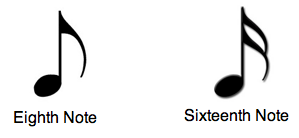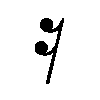Sixteenth notes are type of musical notation that is played very fast and represents 1/16 of a whole measure.
Sixteenths are almost identical to an eighth note. An eighth note has one flag and a sixteenth has two.
There are two ways that you might see this type of note written in a piece of music. The first is a sixteenth written by itself. This will look like an individual note with two flags off of the stem. The other way you will see this note is when two or more are together or side by side. These notes together will have the flags connected.
 |  |
Subdivision of Sixteenths
Each note represents a sixteenth of a whole note. This note can be subdivided into 1/16th of a whole measure. So there are sixteen sixteenth notes in in each measure in four four time.
Each measure in a piece of music is made up of four beats. These four beats are called quarter notes since there are four of them in one measure. If you look at the image below you can see how each a sixteenth can be subdivided from a quarter note.

There are eight eighth notes in four quarter notes and sixteen sixteenths in eight eighth notes.
How to Count Sixteenths
Counting sixteenths is mouth full. Starting at the beginning of the measure it goes one e and a, two e and a, three e and a, four e and a.

Click play on the above player to hear how to count these notes.
The first note is called one and each consecutive note is given e, and, a.
The entire phrase looks like this. One-e-and-a
Counting Sixteenths With Other Notes
These notes will commonly be combined with other notes. In order to read these notes along with others you need to count the other notes in this same One-e-and-a pattern.
This makes it easier to count the correct time that each note receives without confusing yourself while counting.
Look at the example and you will see how it makes it much easier to count this set of notes while keeping the pattern we learned above.

You don’t have to count using the pattern but it makes it a lot easier to keep track of the timing of the other notes because things are starting to get really fast.
Sixteenth Rest
A sixteenth rest is identical to a sixteenth note except instead of playing a note you don’t play anything, you rest.
The sixteenth rest is 1/4 of one beat.

Look at the image above and you can see how the sixteenth rest is similar to a sixteenth note. It also has two flags coming off the main stem.
This rest is very fast and can be counted just like a regular note.
Sixteenth Examples
There are many different types of patterns that you will see sixteenths in. Here are a few examples of note patterns.
Remember to count these notes with the phrase we learned above to keep in time with the music One-e-and-a, Two-e-and-a, Three-e-and-a, Four-e-and-a



The sixteenth can be difficult to count especially along with other notes in the same measure. With practice, it will become easier and almost spontaneous and you won’t even have to think about it.
